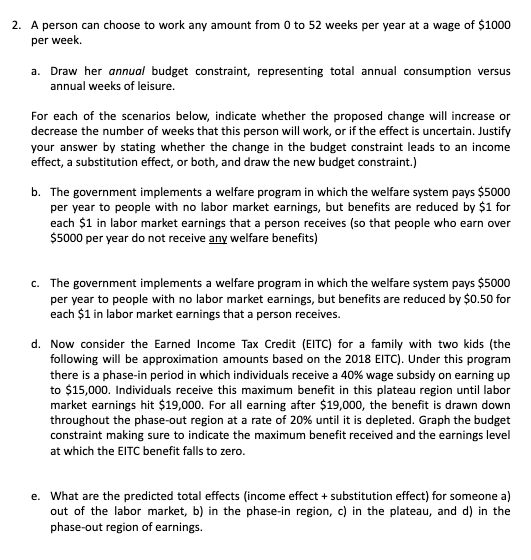2. A person can choose to work any amount from 0 to 52 weeks per year at a wage of $1000 per week. a. Draw her annual budget constraint, representing total annual consumption versus annual weeks of leisure. For each of the scenarios below, indicate whether the proposed change will increase or decrease the number of weeks that this person will work, or if the effect is uncertain. Justify your answer by stating whether the change in the budget constraint leads to an income effect, a substitution effect, or both, and draw the new budget constraint.) b. The government implements a welfare program in which the welfare system pays $5000 per year to people with no labor market earnings, but benefits are reduced by $1 for each $1 in labor market earnings that a person receives (so that people who earn over $5000 per year do not receive any welfare benefits) c. The government implements a welfare program in which the welfare system pays $5000 per year to people with no labor market earnings, but benefits are reduced by $0.50 for each $1 in labor market earnings that a person receives.
2. A person can choose to work any amount from 0 to 52 weeks per year at a wage of $1000 per week. a. Draw her annual budget constraint, representing total annual consumption versus annual weeks of leisure. For each of the scenarios below, indicate whether the proposed change will increase or decrease the number of weeks that this person will work, or if the effect is uncertain. Justify your answer by stating whether the change in the budget constraint leads to an income effect, a substitution effect, or both, and draw the new budget constraint.) b. The government implements a welfare program in which the welfare system pays $5000 per year to people with no labor market earnings, but benefits are reduced by $1 for each $1 in labor market earnings that a person receives (so that people who earn over $5000 per year do not receive any welfare benefits) c. The government implements a welfare program in which the welfare system pays $5000 per year to people with no labor market earnings, but benefits are reduced by $0.50 for each $1 in labor market earnings that a person receives.
Chapter16: Labor Markets
Section: Chapter Questions
Problem 16.1P
Related questions
Question
2. Part a, b, c

Transcribed Image Text:2. A person can choose to work any amount from 0 to 52 weeks per year at a wage of $1000
per week.
a. Draw her annual budget constraint, representing total annual consumption versus
annual weeks of leisure.
For each of the scenarios below, indicate whether the proposed change will increase or
decrease the number of weeks that this person will work, or if the effect is uncertain. Justify
your answer by stating whether the change in the budget constraint leads to an income
effect, a substitution effect, or both, and draw the new budget constraint.)
b. The government implements a welfare program in which the welfare system pays $5000
per year to people with no labor market earnings, but benefits are reduced by $i for
each $1 in labor market earnings that a person receives (so that people who earn over
$5000 per year do not receive any welfare benefits)
c. The government implements a welfare program in which the welfare system pays $5000
per year to people with no labor market earnings, but benefits are reduced by $0.50 for
each $1 in labor market earnings that a person receives.
d. Now consider the Earned Income Tax Credit (EITC) for a family with two kids (the
following will be approximation amounts based on the 2018 EITC). Under this program
there is a phase-in period in which individuals receive a 40% wage subsidy on earning up
to $15,000. Individuals receive this maximum benefit in this plateau region until labor
market earnings hit $19,000. For all earning after $19,000, the benefit is drawn down
throughout the phase-out region at a rate of 20% until it is depleted. Graph the budget
constraint making sure to indicate the maximum benefit received and the earnings level
at which the EITC benefit falls to zero.
e. What are the predicted total effects (income effect + substitution effect) for someone a)
out of the labor market, b) in the phase-in region, c) in the plateau, and d) in the
phase-out region of earnings.
Expert Solution
Step 1
Given:
Time=0-52 weeks
Wage per week=$1000
Trending now
This is a popular solution!
Step by step
Solved in 4 steps with 3 images

Knowledge Booster
Learn more about
Need a deep-dive on the concept behind this application? Look no further. Learn more about this topic, economics and related others by exploring similar questions and additional content below.Recommended textbooks for you


Exploring Economics
Economics
ISBN:
9781544336329
Author:
Robert L. Sexton
Publisher:
SAGE Publications, Inc

Principles of Microeconomics
Economics
ISBN:
9781305156050
Author:
N. Gregory Mankiw
Publisher:
Cengage Learning


Exploring Economics
Economics
ISBN:
9781544336329
Author:
Robert L. Sexton
Publisher:
SAGE Publications, Inc

Principles of Microeconomics
Economics
ISBN:
9781305156050
Author:
N. Gregory Mankiw
Publisher:
Cengage Learning